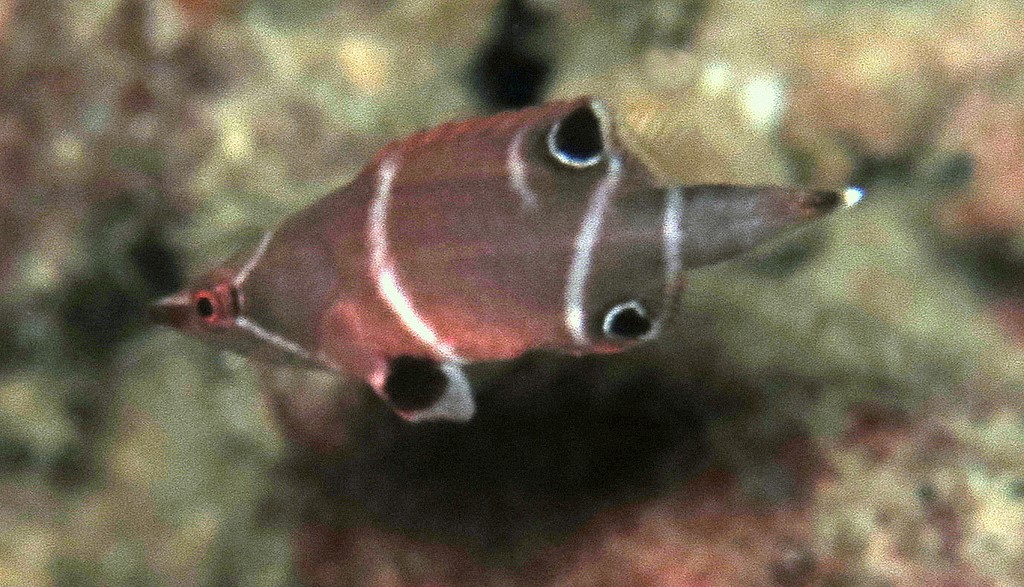WETMORELLA ALBOFASCIATA - (SCHULTZ & MARSHALL, 1954)
Picture courtesy of: Alain Daoulas
Actinopterygii (Gigaclass) > Actinopteri (Class) > Teleostei (Subclass) > Labriformes (Order) > Labroidei (Suborder) > Labridae (Family) > Wetmorella (Genus)
Labre nain à lignes double, Doubleline wrasse, Diagonal-lined wrasse, Double-lined wrasse, White banded possum wrasse, White-banded possum-wrasse, White-banded possum Wrasse, Whitebanded sharpnose wrasse, White-barred pigmy wrasse, 白条湿鹦鲷,
Description
Dorsal spines (total): 9; Dorsal soft rays (total): 10-11 (usually:10); Anal spines: 3; Analsoft rays: 8; Pectoral fins rays: 12. Body depth: 2.8-3.3 in SL; Head long: 2.4-2.6 in SL; Head profile straight from upper lip to above eyes, then slightly convex on nape; Snout length: 3.2-3.4 in HL; Eyes subequal to snout length; Longest dorsal fin spine: 1.9-2.3 in HL; Third anal fin spine: 2.0-2.3 in HL. Gill Rakers: 11-16, short. Lateral line scales: 13-15 + 5-7; Vertebrae: 23. One predorsal bone. Premaxilla protractile. Spinous portions of dorsal and anal fins deeply incised. Max. length: 6.0 cm TL, common length: 4.5 cm TL. Depth range: 8 - 42 m.
Actinopterygii (Gigaclass) > Actinopteri (Class) > Teleostei (Subclass) > Labriformes (Order) > Labroidei (Suborder) > Labridae (Family) > Wetmorella (Genus)
Labre nain à lignes double, Doubleline wrasse, Diagonal-lined wrasse, Double-lined wrasse, White banded possum wrasse, White-banded possum-wrasse, White-banded possum Wrasse, Whitebanded sharpnose wrasse, White-barred pigmy wrasse, 白条湿鹦鲷,
Description
Dorsal spines (total): 9; Dorsal soft rays (total): 10-11 (usually:10); Anal spines: 3; Analsoft rays: 8; Pectoral fins rays: 12. Body depth: 2.8-3.3 in SL; Head long: 2.4-2.6 in SL; Head profile straight from upper lip to above eyes, then slightly convex on nape; Snout length: 3.2-3.4 in HL; Eyes subequal to snout length; Longest dorsal fin spine: 1.9-2.3 in HL; Third anal fin spine: 2.0-2.3 in HL. Gill Rakers: 11-16, short. Lateral line scales: 13-15 + 5-7; Vertebrae: 23. One predorsal bone. Premaxilla protractile. Spinous portions of dorsal and anal fins deeply incised. Max. length: 6.0 cm TL, common length: 4.5 cm TL. Depth range: 8 - 42 m.
Color
Body dark reddish to yellowish brown, with narrow white bar from 2nd dorsal-fin spine to mid-abdomen; Large ocellated black spot in front of soft-rayed portions of dorsal and anal fins; Narrow oblique white band rimming rear edge of dorsalfin black spot and crossing body obliquely to outer half of second anal-fin spine; White line across peduncle; Head with two curved white lines passing through each eye, one from upper lip to nape, other from behind corner of mouth to pelvic-fin origin; Caudal fin mostly translucent, with brown rays, brown at base, and broad blackish bar on most of outer half of fin, followed by narrow translucent zone and narrow white margin; Pelvic fins largely covered by reddish black spot, with small white spot at fin origin and on outer white margin.
Etymology
Wetmorella: genus created, in 1928, by Fowler & Beam for Dr. Alexander Wetmore, assistant secretary, United States National Museum, in slight appreciation of his interest in our work on Philippine ichthyology.
albofasciata: from ancient Greek alphós = whiteness, white (properly without luster), dull white + from Latin, fasciatus = banded. Referring to white slightly diagonal bands on body.
Original description: Wetmorella albofasciata Schultz & Marshall, 1954 - Type locality: Mabul Island, off southeastern Sabah, Malaysia.
Distribution
Indo-West Pacific: East Africa, Agalega Islands and Aldabra (Seychelles), Comoros and Madagascar east to Hawaiian Islands (U.S.A.) and Society Islands (French Polynesia), north to Philippines, south to Western Australia, New Caledonia and Tonga.
Biology
Inhabit caves or crevices of lagoon and seaward reefs and drop-offs. Benthic and benthopelagic. Secretive.
Similar species
Last update: 23, March 2023
Etymology
Wetmorella: genus created, in 1928, by Fowler & Beam for Dr. Alexander Wetmore, assistant secretary, United States National Museum, in slight appreciation of his interest in our work on Philippine ichthyology.
albofasciata: from ancient Greek alphós = whiteness, white (properly without luster), dull white + from Latin, fasciatus = banded. Referring to white slightly diagonal bands on body.
Original description: Wetmorella albofasciata Schultz & Marshall, 1954 - Type locality: Mabul Island, off southeastern Sabah, Malaysia.
Distribution
Indo-West Pacific: East Africa, Agalega Islands and Aldabra (Seychelles), Comoros and Madagascar east to Hawaiian Islands (U.S.A.) and Society Islands (French Polynesia), north to Philippines, south to Western Australia, New Caledonia and Tonga.
Biology
Inhabit caves or crevices of lagoon and seaward reefs and drop-offs. Benthic and benthopelagic. Secretive.
Similar species
- Cheilinus fasciatus (Bloch, 1791) - Reported from New Caledonia - Link to the species (here) - Small juveniles often mistaken because of the thin vertical white barring.
- Epibulus insidiator (Pallas, 1770) - Reported from New Caledonia - Link to the species (here) - Small juveniles often mistaken because of the thin vertical white barring.
- Wetmorella bifasciata (Schultz & Marshall, 1954) - Reported from Red Sea; Indo-West Pacific: Gulf of Aden, East Africa, Seychelles, Comoros, Madagascar and Mascarenes (Mauritius) east to Philippines. Body of adults red to reddish brown, with narrow pale yellowish bar anteriorly on peduncle, and curved yellow line from nape to lower corner of opercle, touching eye with its convex anterior edge.
- Wetmorella nigropinnata (Seale, 1901) - Reported from New Caledonia - Link to the species (here) - Small juveniles often mistaken because of the thin vertical white barring.
- Wetmorella tanakai (Randall & Kuiter, 2007) - Reported from Indonesia and Philippines.
Last update: 23, March 2023
